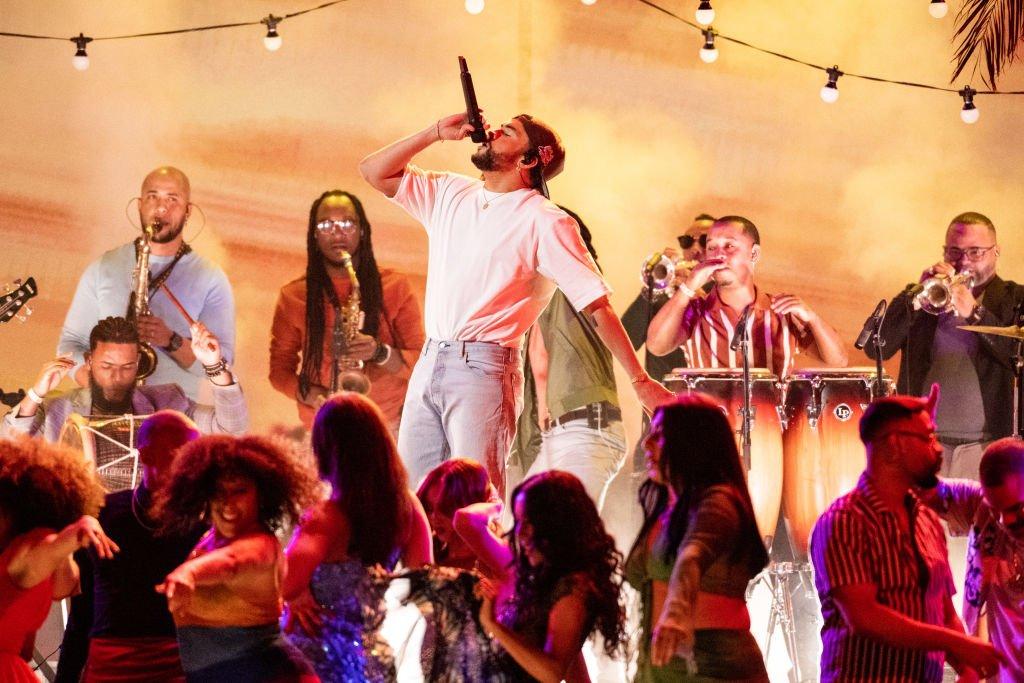Once a marginalized genre associated with lewdness and criminality — much like the genres from which it draws so much influence, dancehall and hip-hop — reggaeton is now firmly in the mainstream. While dominant across Latin America in the new millennium, reggaeton has made huge inroads with English-speaking audiences in the past decade, particularly with crossover hits like "Bailando," "Despacito," and numerous Bad Bunny songs from the past three years.
Although many associate reggaeton with Puerto Rico, the roots of the genre can be found in Panama, with artists like El General and Nando Boom taking Jamaican dancehall riddims — like dembow, first introduced in the Shabba Ranks song of the same name — and rapping in Spanish over them in the early 1990s. In Puerto Rico, early reggaeton was called "underground," and gained popularity in the mid-1990s through mixtapes put out by DJs like Playero and Negro, who utilized hip-hop techniques to alter the dancehall riddims as an instrumental track for local rappers and singers like Daddy Yankee.
Reggaeton has long been a male-dominated genre (with Ivy Queen being the main exception to the rule), but in recent years female singers have become more prominent. Colombian singer Karol G, for example, is currently one of the genre’s biggest stars, and Spanish singer Rosalía pivoted to reggaeton for her 2022 album Motomami, which won a Latin GRAMMY for Album Of The Year.
Colombian artists have also been making their way to the top of the reggaeton charts in recent years — alongside Karol G, there’s J Balvin and Maluma — although Puerto Rican artists still dominate the genre, with current stars like Rauw Alejandro and Anuel AA.
Reggaeton will only continue to evolve and develop; read on for 10 songs that represent the sonic and cultural evolution of the genre in the past three decades.
El General - "Tu Pum Pum" (1990)
Years before the term reggaeton was invented, Panamanian rapper El General (Edgardo Franco) was the first artist to gain recognition recording reggae en español. Given the history of West Indian immigration to Panama to build the Canal, it’s not surprising that the story of reggaeton begins there. This proto-reggaeton style emulated Jamaican dancehall much more closely than later styles would. El General and his friends got started by taking Jamaican riddims like the genre-defining dembow and rapping in Spanish over them; they used to board buses in Panama City and perform for fellow riders. El General was known as a skilled improvisor.
He moved to New York to study in the late 1980s, and hooked up with fellow Panamanian and producer Michael Ellis, who is said to have invented the term "reggaeton." El General’s first hit, "Tu Pun Pun" is a Spanish-language version of Jamaican dancehall artist Little Lenny’s 1990 song "Punnany Tegereg" that’s quite faithful musically to the original.
The title of the song is slang for female genitals, and the lyrics chronicle El General’s sexual prowess in graphic detail. Its chorus chants, "Your pum pum, baby baby, won’t kill (tame) me." The song became a hit in the U.S. and El General went on to have a successful, albeit brief, career.
Tego Calderón - "Pa’ Que Retozen" (2003)
One of the biggest tracks on Tego Calderón’s debut album, El Abayarde, "Pa’ Que Retozen" was a party anthem and one of the first reggaeton hits in the U.S. It represents the culmination of many musical shifts that took place during the 1990s in Puerto Rico. By the mid-1990s, the dembow riddim began to dominate the Puerto Rican underground scene. As the millennium approached, DJs and producers began to incorporate elements of Latin popular music genres as well.
"Pa’ Que Retozen" is a good example of this trend, as bachata-style guitar riffs play underneath Calderón’s rapping. The background track switches up several times in this song, including an incredibly catchy, high-pitched synth riff heard in the second verse. Other tracks on El Abayarde also incorporate Latin genres and instruments — like bongó drums on "Abayarde," Afro-Puerto Rican bomba percussion on "Loíza," and a full salsa orchestra and vocals on "Planté Bandera."
Ivy Queen - "Quiero Bailar" (2002)
Known as the "Queen of Reggaeton," Ivy Queen was the only prominent female reggaeton artist for nearly two decades. She released two albums in the late 1990s, but it was her third album, Diva, in 2003, that really broke through. Ivy Queen intentionally wrote from a female perspective, as she had come up in a male-dominated scene in San Juan where women were constantly being objectified.
With her deep, throaty vocal tone, Ivy Queen proclaims on "Quiero Bailar" that although she wants to dance — even in the sexualized perreo style that had become synonymous with reggaeton — that doesn’t necessarily mean she wants to have sex with her dance partner. The song is still an important anthem for women who want to feel free to bump and grind and express themselves on the dancefloor without men expecting a sexual encounter.
Don Omar - "Dile" (2003)
Three of the genre’s most influential artists exploded on the scene at roughly the same time: Calderón, Daddy Yankee and Don Omar, with the latter two involved in a rivalry for the title of "King of Reggaeton." However, Don Omar always stood out among the three for the lyricism of his voice — he was a more gifted singer than many of his peers.
His debut album, The Last Don, is considered to be a classic, utilizing a similar approach as Calderón of injecting more melodic Latin styles, like bachata and salsa, into his music. The Dominican production team Luny Tunes, who was instrumental in expanding the sound of reggaeton and distinguishing it further from its Jamaican roots, produced about half the album’s tracks.
Like "Pa’ Que Retozen," Don Omar’s first major single, "Dile" relies heavily on a bachata guitar line, but his vocal style is quite different from the deep, resonant rapping of Calderón. The combination of Don Omar’s tenor voice with the melodic instrumentals of "Dile" makes for a very aesthetically pleasing, yet danceable song. In addition, he interpolates a salsa song, Joe Arroyo’s "La Noche," into a bridge-like section in the middle of "Dile."
The subject matter is also more emotional than many reggaeton songs had been up to this point, as he’s pleading with a woman to tell her boyfriend that she wants to be with someone else (Don Omar).
Daddy Yankee - "Gasolina" (2004)
The first reggaeton song to be nominated for Record Of The Year at the Latin GRAMMYs, "Gasolina" still stands as the genre’s most iconic and recognizable song. The song catapulted not only Daddy Yankee into the mainstream, but also the genre itself. It appeared on Daddy Yankee’s third studio album, Barrio Fino, which broke numerous records and won many awards.
Barrio Fino took a broad approach, which proved incredibly successful. Many of the album’s tracks were produced by Luny Tunes, including its two biggest hits, "Gasolina" and "Lo Que Pasó, Pasó." The album also features a salsa-reggaeton fusion and an R&B-inflected rap song that sounds like it could have been recorded by Big Pun.
As for the concept behind "Gasolina," Daddy Yankee was living in a San Juan housing project with his family, where he often heard people on the street shouting, "iComo le gusta las gasolina!" ("How she likes gasoline!"), referring to women who accept rides from men with nice cars. He took that phrase and ran with it, creating the famous hook "A mí me gusta la gasolina, dame más gasolina" ("I like gasoline, give me more gasoline"). A decade later he laughed at the idea that the term "gasolina" referred to drugs — as many people assumed — claiming that he used it literally, to refer to cars.
"Oye Mi Canto" - N.O.R.E., feat. Nina Sky, Gem Star, Daddy Yankee, and Big Mato
Reggaeton exploded in popularity in the mid-aughts, which explains why there are so many classic songs from that time period. "Oye Mi Canto" was the first collaboration between an American rapper (N.O.R.E.) and reggaeton artists, and included verses in English and Spanish.
The song originally featured Tego Calderón but Daddy Yankee replaced him in the video. It also signaled an acceptance of reggaeton by New York hip hop artists — Fat Joe also appears in the video. It peaked at No. 12 on the Billboard Top 100, a first for a reggaeton song.
The song utilizes a common feature of commercial hip hop at the time, a catchy R&B hook sung by a female vocalist, Nina Sky. The hook borrows from and adapts the recognizable chorus "Boricua, morena, Boricua, morena," which was heard on Big Pun’s massive 1998 hit "Still Not A Player," but extends it to include other Latino ethnicities beyond "Boricua" (Puerto Rican).
Calle 13 -"Atrévete-te-te" (2005)
Hardly a traditional reggaeton group, Calle 13 nonetheless created one of the genre’s most popular, beloved songs in 2005 with their irreverent hit "Atrévete-te-te." Rapper Residente and instrumentalist/producer Visitante, step-brothers, founded the group in 2004, and gained fame with a song about the FBI killing of Puerto Rican independence leader Filiberto Ojeda Ríos called "Querido FBI."
Residente is the most politically outspoken rapper within reggaeton, a genre the two musicians have tended to distance themselves from, preferring not to be labeled. The group’s music has always been eclectic, using live instrumentation and unusual timbres. These elements undoubtedly relate to the fact that Visitante plays dozens of instruments. The brothers still hold the record for most Latin GRAMMY Awards in history, a whopping 27 each!
"Atrévete-te-te" is an infectious cumbia-reggaeton hybrid featuring an unforgettable high-register clarinet. Residente’s lyrics are raunchy, witty, and replete with American pop culture references and anglicisms. He dares a "Miss Intellectual" to get down off her culturally elitist high horse and let loose: "I know you like Latin pop rock, but reggaeton gets into your intestines, under your skirt like a submarine, and brings out your ‘Taino’ (indigenous people native to Puerto Rico)." He reinforces his point later, singing, "Who cares if you like Green Day? Who cares if you like Coldplay?"
"Bailando" - Enrique Iglesias feat.Descemer Bueno and Gente de Zona (2014)
In the 2010s reggaeton’s popularity continued to grow, and "Bailando" was one of the songs that significantly raised the genre’s visibility among English-language audiences. Nonetheless, Spanish pop singer Enrique Iglesias originally didn’t like the song.
"Bailando" was written and recorded by Cuban singer/songwriter Descemer Bueno and Cuban reggaeton duo Gente de Zona, who had become one of the island’s biggest musical groups. When Iglesias heard Bueno’s recording, he changed his mind and they added his vocals.
Garnering many awards, and winning Song of the Year at the 2014 Latin GRAMMYs, "Bailando" was flamenco-infused reggaeton designed for mass appeal. It follows a traditional pop song format, with Iglesias singing the verses and trading off with Gente de Zona and Bueno in the extended chorus sections. The lyrics are standard love song fare, and don’t include any of the rapped vocals or Cuban slang that had made Gente de Zona so popular in Cuba. Nonetheless, it peaked at No. 2 on the Billboard Hot 100 and spent a record-breaking 41 weeks at the top of the U.S. Latin charts.
"Despacito" - Luis Fonsi featuring Daddy Yankee, with a remix feat. Justin Bieber (2017)
Love it or hate it, it’s impossible to ignore the cultural impact of "Despacito." It was already a huge hit in its original version, by Puerto Rican singer Luis Fonsi and Daddy Yankee. But when Justin Bieber called Fonsi up to inquire about doing a remix, it became 2017’s song of the summer.
Like "Bailando," the original version was already as much Latin pop as it was reggaeton, and although Daddy Yankee has some rapped vocals in the second verse, he’s mainly singing as well. The producers decided to use a Puerto Rican cuatro, which opens the song, in addition to an acoustic guitar in order to give the song a more local feel. One unique element was the insertion of a rhythmic break right before the chorus "Despacito" (which translates to "slowly") comes in. The way Fonsi breaks up the three syllables in the title word, taking his time with them, is a nice touch.
The Justin Bieber remix was released three months later, and maintained the song’s original rhythms and Daddy Yankee’s verses. An English verse was added for Bieber at the beginning of the song, and he sang the "Despacito" choruses in Spanish — the first time he’d ever sung in Spanish. It quickly rose to No. 1 on the Hot 100 charts, which gave Fonsi and Daddy Yankee their first No. 1 hit. It stayed at the top of the charts for 16 weeks, tying with "One Sweet Day," by Mariah Carey and Boyz II Men, and remained the longest-leading No. 1 single until 2019. "Despacito" also won Song and Record Of The Year at the Latin GRAMMYs.
"Titi Me Preguntó" - Bad Bunny (2022)
Bad Bunny is not only the most prominent artist in contemporary reggaeton — he was the biggest artist in the world in 2022. It’s impossible to list all of the accolades Benito Antonio Martínez Ocasio has attained in his short career, but here are a few: His latest, Un Verano Sin Tí, was the first Spanish-language one to be nominated for Album Of The Year at the 2023 GRAMMYs, he's been Spotify's most streamed artist in the world for three straight years.
Un Verano Sin Tí was a masterful achievement, showcasing a wide variety of contemporary Latin music beyond reggaeton, including Dominican dembow and mambo, bachata, electro-cumbia, and even indie rock — all anchored by Bad Bunny’s emo vocal style. The album is a celebration of Spanish Caribbean identity, paying homage as much to Dominican as to Puerto Rican music.
"Titi Me Preguntó" is not only one of the album’s biggest hits, but also one of its most complex tracks, featuring several discrete sections. It begins with a bachata guitar intro, followed by Bad Bunny’s rapped vocals accompanied by a sparse backbeat. His aunt is asking why he goes out with so many girls and won’t settle down. The body of the song speeds way up, keeping a sparse accompaniment, as Bad Bunny lists the names and cities of different girlfriends.
But there’s an interesting shift at the 2:15 mark, where the bachata guitar returns and we hear a woman’s voice admonishing him for being an f-boi. It’s followed by anguished Bad Bunny vocals singing, "I’d like to fall in love but I can’t." The music changes back to the sparse backbeat accompaniment when he sings: "I don’t even trust myself," and notes how many women say they want to have his first-born child. The singing returns, as a spooky electronica melody is added into the background mix: "Listen to your friend, I’ll only break your heart…I don’t know why I’m like this."
This is a man struggling with interpersonal demons, and this vulnerable masculinity (and his past refusal to conform to rigid gender norms) is precisely why Bad Bunny is so beloved by his female fans.
The Evolution Of Bollywood Music In 10 Songs: From "Awaara Hoon" To "Naatu Naatu"




